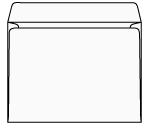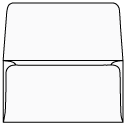
| Blank: A die cut sheet envelope shape before it is folded. |  |
Bleed: When the printed image extends pas the edge of the envelope.
Booklet: A side seam envelope with flap on the long side. |
 |
BRE (Business Reply Envelope): An envelope printed with the return address and indicia.
| Catalog: A large center seam envelope with flap on the short side. Also known as Open End. |  |
Commercial: General term to describe most business style envelopes. This is open side with diagonal seams.
Corner Copy: A return address and logo on the upper left hand corner.
Cross Cut: Envelopes cut so that the paper grain is perpendicular to the paper side seam fold.
This makes the envelope more difficult to fold.
| Diagonal Seam: Two side flaps joined with the back flap so that the seams run diagonally on the back of the envelope. |
 |
FIM (Facing Identification Markings): Printed vertical bars on the top right corner of the envelope for post office machines to read.
Flexo (Inline): A form of printing using flexible rubber plates on rotary press. Printing and folding are done complete in one operation.
Halftone: Picture with gradations of tone, formed by dots of varying sizes in one color.
Glassine: A biodegradable, semitransparent paper sometimes used for window patch.
Grain: The direction most of the fibers lie on the sheet of paper.
Gripper Edge: The leading edge of paper as it passes through a printing press or folder.
Indicia: Printed postal permit on upper right hand corner of envelope.
Inside Tint: Printed design on the inside of the envelope. Used for added opacity or graphic interest.
Jet Printing (Offset): Printing press setup to print on already manufactured envelopes. Avails fast, high quality turnaround.
Jogged: Process using vibration to register a stack of paper.
Kraft: A paper grade made from unbleached, bleached or colored wood pulp by the sulfate process. Most commonly used the manufacture of Catalog or Booklet envelopes.
Latex Seal: A rubber-based adhesive for self-seal envelopes. Adhesive is placed on the flap and back of the envelope.
When the two strips of latex gum are pressed together, they create a bond which seals the envelope.
Offset Paper: Also known as text or book paper. Designed to be used in printing by lithography.
Perfecting: Refers to printing on both sides of the envelope on a single pass through the Jet Press.
Perforation: Creating a line of small dotted holes into a piece of paper to make tearing easy.
Regular: An envelope with no window.
| Remittance: An envelope with a large flap, approximately the same size of the envelope. |  |
Remoistenable Seal Gum: The envelope becomes permanently sealed when moisture is applied to the gum.
| Side Seam: Envelope configuration with two narrow side seams and a square back panel. |  |
Split Seal Gum: Remoistenable Seal Gum that is split where the flap overlaps the diagonal seams.
Tint: Printing on the inside of the envelope to increase opacity for security.
Web: Envelope is manufactured using a continuous roll of paper where cutting and folding is done on one machine.
Zip Strip Seal: Uses self-adhearing strip of gum applied to the flap and protected with a strip of coated release paper.
Copyright 2021

